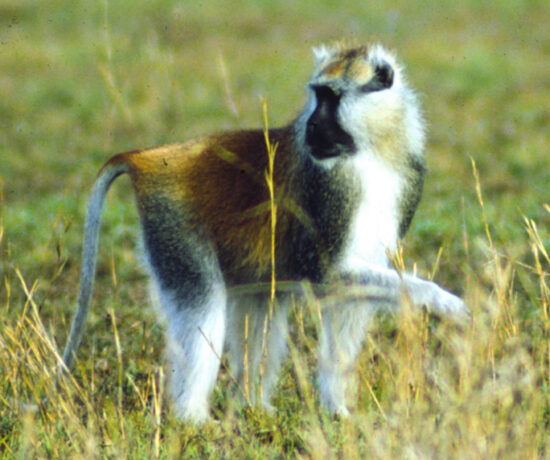On the Edge of Extinction: The Plight of the Southern Patas Monkey
Thomas M. Butynski and Yvonne A. de Jong
Swara Magazine – July 2024

Southern patas monkey Erythrocebus baumstarki at Serengeti NP, Tanzania. Photograph by George Schaller.
References:
BurnSilver, S.B., Worden, J. and Boone, R.B. (2008). Processes of fragmentation in the Amboseli Ecosystem, southern Kajiado District, Kenya. In: Fragmentation in Semi-arid and Arid Landscapes: Consequences for Human and Natural Systems, K.A. Galvin, R.S. Reid, R.-H. Behnke Jr. and N.T. Hobbs (eds.), pp. 225–253. Springer, Dordrecht, The Netherlands. Website
Butynski, T.M. and De Jong, Y.A. (2022). Southern patas monkey Erythrocebus baumstarki. In: Primates in Peril: The World’s 25 Most Endangered Primates 2022–2023, R.A. Mittermeier, K.E. Reuter, A.B. Rylands, L. Jerusalinsky, C. Schwitzer, K.B. Strier, J. Ratsimbazafy and T. Humle (eds.), pp. 38–41. IUCN SSC Primate Specialist Group, International Primatological Society, Re:wild, Washington, DC. Website
Chism, J. and Rowell, T.E. (1988). The natural history of patas monkeys. In: A Primate Radiation: Evolutionary Biology of the African Guenons, A. Gautier-Hion, F. Bourlière, J.P. Gautier and J. Kingdon (eds.), pp. 412–438. Cambridge University Press, Cambridge, UK.
De Jong, Y.A. and Butynski, T.M. (2020). Erythrocebus baumstarki. The IUCN Red List of Threatened Species 2020: e.T92252436A92252442. Website
De Jong, Y.A. and Butynski, T.M. (2021). Is the southern patas monkey Erythrocebus baumstarki Africa’s next primate extinction? Reassessing taxonomy, distribution, abundance, and conservation. Am. J. Primatol. e23316.10.1002/ajp.23316. Website
De Jong, Y.A., Butynski, T.M. and Nekaris, K.A.-I. (2008). Distribution and conservation of the patas monkey Erythrocebus patas in Kenya. J. East Afr. Nat. Hist. 97: 83–102. Website
De Jong, Y.A., Butynski, T.M., Isbell, L.A. and Lewis, C. (2009). Historic and current distribution of the southern patas monkey Erythrocebus patas baumstarki in Tanzania. Oryx 43: 267–274. Website
Hall, K.R.L. (1965). Behavior and ecology of the wild patas monkey (Erythrocebus patas) in Uganda. J. Zool., Lond. 148: 15–87. Website
Holmern, T., Muya, J. and Røskaft, E. (2007). Local law enforcement and illegal bushmeat hunting outside the Serengeti National Park, Tanzania. Environ. Conserv. 34: 55–63. Website
Homewood, K., Lambin, E.F., Coast, E., Kariuki, A., Kikula, I., Kivelia, J., Said, M., Serneels, S. and Thompson, M. (2001). Long-term changes in Serengeti-Mara wildebeest and land cover: pastoralism, population, or policies. PNAS 98: 12544–12549. Website
Isbell, L.A. (1998). Diet for a small primate: insectivory and gummivory in the (large) patas monkey (Erythrocebus patas pyrrhonotus). Am. J. Primatol. 45: 381–398. Website
Isbell, L.A. (2013). Erythrocebus patas Patas Monkey (Hussar Monkey, Nisnas). In: Mammals of Africa. Volume II: Primates, T.M. Butynski, J. Kingdon and J. Kalina (eds.), pp. 257–264. Bloomsbury Publishing, London, UK.
Isbell, L.A. and Chism, J. (2007). Distribution and abundance of patas monkeys (Erythrocebus patas) in Laikipia, Kenya, 1979–2004. Am. J. Primatol. 69: 1223–1235. Website
Loibooki, M., Hofer, H., Campbell, J.L.I. and East, M.L. (2002). Bushmeat hunting by communities adjacent to the Serengeti National Park, Tanzania: the importance of livestock ownership and alternative sources of protein and income. Environ. Conserv. 29: 391–398. Website
Loishooki, A.G., Kihwele, E.S., Nasari, D.S. and Mafuru, G. (2016). Assessment of Distribution and Conservation Mitigations of the Patas Monkey (Erythrocebus patas) in Serengeti Ecosystem. Unpublished report by the Unit of Ecological Monitoring, Tanzania National Parks, Arusha, Tanzania.
Makacha, S. and Sirolli, A. (2005). Status and Distribution of Ikoma Patas Monkeys Cercopithecus, (Erythrocebus) patas baumstarki in the Serengeti National Park. Unpublished report by the Serengeti Biodiversity Project, Arusha, Tanzania.
Nyahongo, J.W., Holmern, T., Kaltenborn, B.P. and Røskaft, E. (2009). Spatial and temporal variation in meat and fish consumption among people in the western Serengeti, Tanzania: the importance of migratory herbivores. Oryx 43: 258–266. Website
Ogutu, J.O., Reid, R.O., Piepho, H.-P., Hobbs, N.T., Rainy, M.E., Kruska, R.L., Worden, J.S. and Nyambenge, M. (2014). Large herbivore responses to surface water and land use in an East African savanna: implications for conservation and human-wildlife conflict. Biodiv. Conserv. 23: 573–596. Website
Ogutu, J.O., Piepho, H.-P., Said, M.Y., Ojwang, G.O., Njino, L.W., Kifugo, S.C. and Wargute, P.W. (2016). Extreme wildlife declines and concurrent increases in livestock numbers in Kenya. What are the causes? PLoS One 11: e0163249. Website
Veldhuis, M.P., Ritchie, M.E., Ogutu, J.O., Morrison, T.A., Beale, C.M., Estes, A.B., Mwakilema, W., Ojwang, G.O., Parr, C.L., Probert, J., Wargute, P.W., Hopcraft, J.J.C. and Olff, H. (2019). Cross-boundary human impacts compromise the Serengeti-Mara Ecosystem. Science 363: 1424–1428. Website

